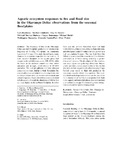Please use this identifier to cite or link to this item:
http://hdl.handle.net/10311/838| Title: | Aquatic ecosystem responses to fire and flood size in the Okavango Delta: observations from the seasonal floodplains |
| Authors: | Ramberg, L. Lindholm, M. Hessen, D.O. Murray-Hudson, M. Bonyongo, C. Heinl, M. Masamba, W. Vanderpost, C. Wolski, P. |
| Keywords: | Seasonal floodplain Macrophyte Okavango Delta Zooplankton biomass Fish productivity |
| Issue Date: | 19-Jul-2010 |
| Publisher: | Springer, http://www.springer.com |
| Citation: | Ramberg, L. et al (2010) Aquatic ecosystem responses to fire and flood size in the Okavango Delta: observations from the seasonal floodplains, Wetlands Ecology and Management, Vol.18, No. 5, pp. 587-595 |
| Abstract: | The frequency of fires in the Okavango Delta seasonal floodplains peaked at an intermediate frequency of flooding. Floodplains are commonly burnt every 3–5 years. This study showed fundamental changes in ecosystem properties due to burning. A burnt seasonal floodplain in the aquatic phase had oxygen levels well above saturation, 100–200%, while the levels in the un-burnt control site were below saturation and, at night, could decline to 10–40% saturation. The total phosphorous and total nitrogen concentrations were similar on both floodplains but considerably enriched relative to inflowing water, due to nutrient release from the flooded soil-sediment and animal droppings. Zooplankton biomass was very high in both systems although the abundance of fish fry was ten times higher on the un-burnt floodplain. In a low flood year the un-burnt floodplain water had high nutrient levels, primary production, methane emission, and subsequent uptake of methane in biota, as well as a high zooplankton biomass. The very high flood the following year showed the opposite with much lower production at all levels owing primarily to greater dilution of nutrients. The abundance of fish, however, was much higher during the high flood year. Macrophytes and litter provide direct shelter for fish fry but also promote low oxygen levels when decaying. Large flooded areas result in high fish production by removing obstacles related to congestion. This interplay between hydroperiod and fire may be crucial for the maintenance of high biological productivity both in the aquatic and terrestrial phases in a very nutrient poor wetland landscape. Understanding these interactions is crucial for optimal management. |
| URI: | http://hdl.handle.net/10311/838 |
| Appears in Collections: | Research articles (ORI) |
Files in This Item:
| File | Description | Size | Format | |
|---|---|---|---|---|
| Aquatic ecosystem responses to fire and flood size in the Okavango Delta-observations from the seasonal floodplains.pdf | 885.55 kB | Adobe PDF |  View/Open |
Items in DSpace are protected by copyright, with all rights reserved, unless otherwise indicated.
